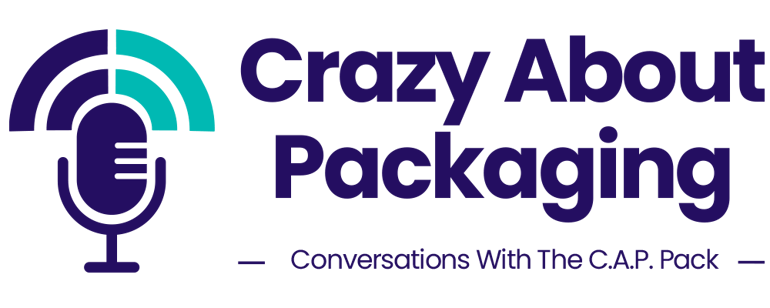
Welcome back to another episode of the Crazy About Packaging podcast. In this episode, Natalie and Jonathan sit down with a very special guest: Brittany LaValley, Vice President of Material Systems at The Recycling Partnership.
This episode takes a closer look at polypropylene recycling and how The Recycling Partnership — and more specifically, the Polypropylene Recycling Coalition — is shaping the future of recovery and reuse for this critical material. If you’ve listened to the show before, you already know how much we love polypropylene. So naturally, we were thrilled to bring on someone equally passionate to talk about how far we’ve come and what’s still ahead.
Sneak Peek for Episode 9
You can listen to this episode of Crazy About Packaging right now on Spotify, Apple Podcasts, or on our website. But if you want a quick preview, keep reading; we’ve pulled out some of the key moments from this insightful discussion on polypropylene recycling.
Introducing Our Guest Host: Brittany LaValley from The Recycling Partnership
Our guest host for this episode didn’t follow a traditional path into packaging. With a background in fine arts and early career experience in operations, Brittany LaValley’s pivot into sustainability was sparked by one fateful meeting that covered how materials flow through a MRF (Material Recovery Facility). That was the moment she decided to focus her career on recycling systems. "I’ve found what I want to dedicate my career to," Brittany said. "It’s this beautiful marriage of caring for the planet and being a total nerd about packaging and systems."
Today, she leads strategy and investment across multiple materials at The Recycling Partnership, including the dedicated Polypropylene Recycling Coalition.
Why the Recycling Partnership Took on Polypropylene
Despite all of its great characteristics, polypropylene’s How2Recycle label was downgraded from “widely recyclable” to “check locally” back in 2020. That was a wake-up call. And it’s what sparked the launch of the Polypropylene Recycling Coalition, which brought together over 20 founding members across the entire value chain.
The mission? Simple but ambitious: Get polypropylene back on track.
The result? Just two years later, polypropylene was able to regain its “widely recyclable” status. Brittany was clear: this didn’t happen by accident. It happened because the coalition invested in real change, issuing over $22 million in grants to more than 60 facilities and improving access to recycling for over 48 million people.
"We saw ourselves as catalyzing change,” Brittany said. “We were banging the drum and saying—we can’t forget about this valuable material."
The Realities (and Challenges) of Recycling Behavior
The conversation also dug into why capturing recyclable material — especially polypropylene — is so challenging. Brittany explained that while over 60% of U.S. households have access to polypropylene recycling, participation is still the biggest gap. And one of the toughest issues? Confusion.
Some consumers throw everything in the bin just in case. Others toss everything out because they’re unsure — the old, “when in doubt, throw it out" mentality.
But this confusion isn’t sustainable; we need a better approach. As Brittany puts it: "We have hundreds of millions of people and only around 400 MRFs in the U.S. Wouldn’t it be easier to upgrade the MRFs than to fix consumer education program by program?"
She shared some of the tools being developed to help, like the Recycle Check tool designed to deliver localized, dynamic recycling guidance to residents based on where they live.
What Makes Polypropylene Worth Fighting For?
One question kept coming up: with all of the materials out there, why did The Recycling Coalition decide that polypropylene was the one they wanted to fight for? And it turns out there were a lot of reasons to keep PP in the recycling stream!
Heat resistance. Chemical resistance. Flexibility. Food-safety. High clarity. Polypropylene is a clean, versatile material that can make a real difference in packaging and, when properly recycled, it’s a big part of the circular economy.
However, there’s a flip side: the versatility of polypropylene also makes it trickier to educate consumers. The material shows up everywhere from kitchen containers to cosmetics packaging. That’s why getting it sorted and recycled properly is critical to keeping PP in the loop.
Looking Ahead: What’s Next for the Coalition?
The Polypropylene Recycling Coalition is now focused on closing the loop: more education, more MRF support, and aligning all of that with new policy developments like EPR (Extended Producer Responsibility) in states like Oregon and California.
Brittany said it best: "Every intervention we’re deploying today, whether it’s grants or education, is being designed to extract key learnings that will help support policy implementation. And eventually, if we do this right, maybe we won’t need the coalition at all."
Thanks for Getting a Little Crazy with Us
Thanks for checking out this month’s episode of Crazy About Packaging, where we took a deep dive into the ever-important topic of polypropylene recycling. Don’t forget to subscribe, leave a review, or send us your questions. Want to join the conversation? We’re on LinkedIn and Instagram, or you can email us at icpg@impactgroup.co.
You can also listen to all past episodes and subscribe on Spotify, Apple, or our website.
See you next month!



